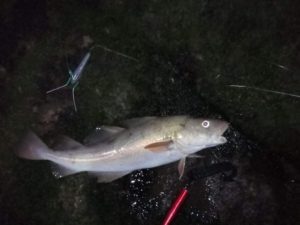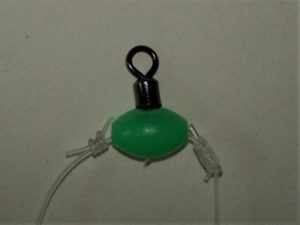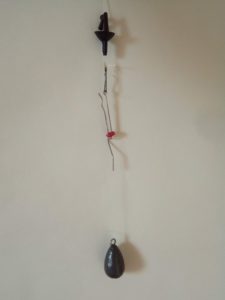
3 simple cod fishing rigs – a rig for every situation
Wouldn’t it be good to have just one cod fishing rig that works everywhere any time? Unfortunately almost every mark I fish asks for a different approach. The following 3 rigs are the ones I use most often when fishing for cod, and they’re all incredibly simple.
*Unless stated otherwise the knot used in this article is the uni knot.

1. Super basic rough ground cod rig
This is probably the rig I use most often, because I use it all year round and not just for cod. It’s the perfect rig for fishing rough ground close in with lighter leads or stone weights.
Components: 1 three way swivel, a hook, a 20lb hook length and 10lb weak link.
Tie your mainline (30lb+) to the top of the swivel, your hook length and hook to the middle and your weak link to the bottom. That’s it. I like to keep my hook length short (5 – 10 inches) and my weak length quite long (1-2 feet) to keep the hook slightly off the bottom and out of the snags. For the weak link I use any old mono, but for my hook lengths I like to use Sunset Amnesia.
It’s the ideal rig for targeting summer cod in calm seas when a gentle lob is all you need. The power of the rig is that you lose the weight without much force (unnoticed even when you have a good fish on). So cheap or free weights are best (as mentioned in my other rig post I prefer to use stones). Needless to say that this rig is not suited for distance casting.
2. Rough ground pulley cod rig clipped down
The pulley rig is not the first rig I go for when fishing straight into the rough, but sometimes you don’t have choice. One of my favourite shallow night marks has a fish holding feature about a 120 yards out, but the ground is extremely rough all the way. So you need a rig you can cast a decent distance with, with as little components as possible, and you need to lift the lead above the fish. It took me a lot of time (and a lot of gear) before I figured this one out.
80lb braid mainline

In this case you need a mainline that is strong enough for the ground but is still thin enough to be able to cast the required distance: 80lb braid straight through (no shock leader) is the best option.
Clever clip
The best ‘fixed’ clip in this scenario is the canny link, which is a rotten bottom clip and a bait clip at the same time. A clipped down rig is essential if you want to reach that distance. You might want to shorten the clips’ ‘hook’ for the weight a bit with a pair of side cutting pliers to make sure it releases every time.
Components: 60lb rig body, 40lb amnesia for snood, 20lb line for weak link, pulley bead, hook, canny link.
Cut off about 2 feet of rig body line. Attach the amnesia hooklength to the thicker line with an albright special knot. (Only cut off the Amnesia from the spool once you know what length you need.) Slide the pulley bead onto the rig body line, then tie a loop knot to the other end. Cut the amnesia just before it reaches the end of the loop, then tie on the hook. Clip the canny link to the loop as demonstrated by its designer Paul Hunter in this video. Then tie on the weak link using an uni-knot.
Canny links are not that well suited for pendulum or off-the ground casting. An overhead cast using a fixed-spool reel is usually enough for the distances I need. As the hook length is under tension when casting, I wouldn’t advise using anything lighter than 40lb otherwise it might break during the cast.
Semi-fix it

You can improve the hooking potential of this rig by trapping the pulley bead with a stop knot. (See rig number 3 below for more details. )
Casting with braid
Casting with braid can hurt, especially if you put a lot of force in your cast. Therefore I always recommend using a casting aid. You can use a finger stall, but I prefer the breakaway casting cannon. The cannon is very easy to use and very hard to lose.
Pulling for a break with braid
Braid can cut into itself and has almost no stretch. Simply pulling back with the hand on the spool causes the coils to cut into each other. It can also damage your reel. Wrapping it around your arm is also a very bad (and dangerous) idea. I always carry a stick with me for this purpose. A wooden priest will do the same job. Wrap the braid around the stick, making sure the coils don’t overlap, and pull back gradually. Because braid has very little stretch you don’t have to ‘walk back’ very far.
When you use the set-up as described in this post, the line should either break at the hook length or the weak link or both. A lot of the time the hook will simply bend out or break. If the rig body itself gets snagged you’ll end up with just the pulley bead. If you use a rig body of a similar or higher breaking strain than your mainline you risk breaking the – expensive – braid (and not necessarily at the rig knot).
3. Semi-fixed pulley pennel cod rig with impact shield
This is my favourite cod rig when fishing relatively clean ground with big baits. This clipped down rig is very aerodynamic and casts really well, even into the wind. A pennel rig allows you to fish big baits without losing out on hooking potential. Bait presentation is also much better than with a single hook. The biggest advantage of using a breakaway impact shield instead of other bait clips is that it doesn’t put any strain on the hook length during the cast. Therefore you can use snoods as light as 12lb (although I prefer the stiffness of 20lb line in most scenarios). It also protects the bait during the cast.
Rotten bottom

When there is any chance of the weight getting snagged, you can easily add a rotten bottom link. The best and safest option is the gemini genie breakers. Unlike most other rottten bottom links you can even use these for pendulum- or of the ground casting. So far I haven’t had these clips fail once. They’re not ideal for very rough ground though, as they are quite expensive and they can get stuck.
Components: pulley bead, swivel, 3 beads, lead clip. 80lbs rig body, 12-40lbs amnesia hooklength, breakaway impact shield, 3/0 pennel hook, 4/0 bottom hook, mono stopknot.

First, tie a 2ft amnesia hooklength to one end of the swivel. Then tie a similar length of rig body line to the other end. Slide two beads onto the line (two beads help the line stand out more). Slide on the pulley bead and another bead behind it. Tie a stop knot behind the last bead. Tie a lead clip onto the other end of the rig body line, and it’s done.
The stop knot basically turns this rig into a paternoster rig. A fixed rig has better hooking potential because there is less play. Bite registration is also a lot better. But when you hook into a fish, the pressure moves the knot and the rig still functions as a pulley rig. The best of both worlds.
For more information about this rig and how to attach the breakaway impact shield, please see my ‘5 easy rigs’ blog post.
If you have any rig tips you like to share, please do so in the comment section below.
And if you’d like to receive an email every time I publish a new post, please subscribe to my newsletter. Tight lines!
Disclosure: if you purchase anything using the links in this blog post, I might make a commission. Affiliate programs and affiliations include, but are not limited to, the eBay Partner Network. It doesn’t cost you a penny more to buy via these affiliate links (and you don’t have to use them of course) but it helps me to keep this blog going. Thanks!


